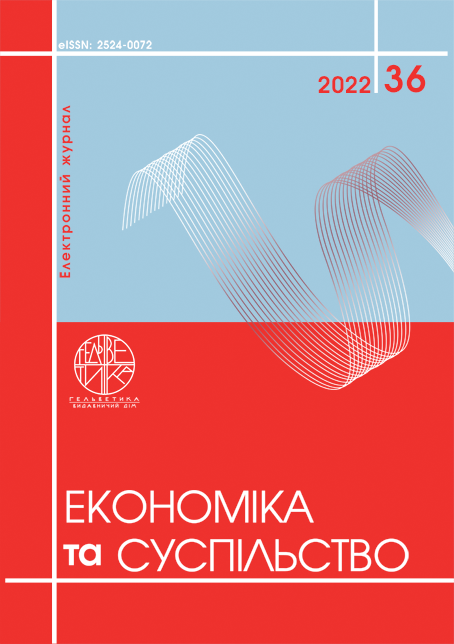MATHEMATICAL AND STRUCTURAL MODELS FOR ASSESSING THE LEVEL OF HUMAN CAPITAL MANAGEMENT
Abstract
The article develops mathematical and structural models for assessing the level of human capital management (HCM). The models are objective and at the same time take into account the subjective assessments of experts, i.e. the results can be easily changed based on changes in expert assessments that take into account changes in the company, goals, mission or specific tasks at the moment. Models are complex in nature, because, using a reasonable set of impact indicators, they generate a comprehensive assessment, the formation of which, along with economic indicators, takes into account the human factor, namely the motivation and satisfaction of staff. The current state of science is associated with the expansion of the use of models to take into account various economic factors, such as linking business performance indicators with market conditions, the development of science and technology, taxation, investment and more. Scientists distinguish the following main categories of economic and mathematical models: models of production processes, models of resource management, models of selection of the best investment projects, models of the dynamics of production assets, models of financial activities of enterprises. These classes of models differ in economic and mathematical tools used for construction and calculations. However, due to significant differences in the basic ideas of these processes, it is difficult to apply existing models to the tasks of assessing the human capital management of the enterprise, given the specific circumstances of each company. This leads to the need to use fundamentally different mathematical tools to solve the problems considered in this study. The following tasks were set in the article: to analyze the theoretical and methodological principles of economic and mathematical modeling of human capital management, to develop a mathematical model for assessing the level of human capital management of the enterprise. The theoretical and methodological basis of the article are the basic provisions of economic theory, the apparatus of artificial intelligence, in particular neural network and system approaches, and so on. The findings can be used by specialists in knowledge management, organizational behavior and personnel needed to develop models for human capital management.
References
Турило А. Концепція оцінки і управління людським капіталом підприємства. Економічний журнал Східноєвропейського національного університету імені Лесі Українки. 2019. Том 2. № 18. DOI: https://doi.org/10.29038/2411-4014-2019-02-44-50
Азарова А. О., Рибко Н. В., Тямушева В. М. Математичне моделювання людського капіталу підприємства. 2020. С. 286300. URL: http://ir.lib.vntu.edu.ua/bitstream/handle/
Матвійчук А. В. Нечіткі, нейромережеві та дискримінантні моделі діагностування можливості банкрутства підприємств. Нейро-нечіткі технології моделювання в економіці. 2013. № 2. С. 71–118. URL: http://nfmte.com/assets/journal/2/Matviychuk.pdf
Мельник Л., Кубатко О., Маценко О.: Трансформація відтворення людського капіталу відповідно до індустрій 4.0 та 5.0 (2021). DOI: https://doi.org/10.21511/ppm.19(2).2021.38
Джавад Аббас (2020). Вплив повного управління якістю на корпоративну стійкість через посередницький ефект управління знаннями. Журнал чистого виробництва, 244, стаття 118806. DOI: https://doi.org/10.1016/j.jclepro.2019.118806
Гущин М. В., Кірєєв О. А., Катаєв А. С. Автоматизована система оцінки ефективності діяльності співробітників підрозділу. Молодий вчений. 2019. № 19 (257). С. 119124. URL: https://moluch.ru/archive/257/58853/
Turilo A. (2019) The concept of evaluation and management of human capital of the enterprise. Economic Journal of the Lesia Ukrainka East European National University. Volume 2. № 18. DOI: https://doi.org/10.29038/2411-4014-2019-02-44-50
Azarova A. A., Rybko N. V., Tyamusheva V. M. (2020). Mathematical modeling of human capital of the enterprise. URL: http://ir.lib.vntu.edu.ua/bitstream/handle/
Matviychuk A. V. (2013) Fuzzy, neural network and discriminant models for diagnosing the possibility of bankruptcy. Neuro-fuzzy modeling technologies in economics. № 2. P. 71–118. URL: http://nfmte.com/assets/journal/2/Matviychuk.pdf
Melnyk L., Kubatko O., Matsenko O. Transformation of human capital reproduction according to industries 4.0 and 5.0 (2021). DOI: https://doi.org/10.21511/ppm.19(2).2021.38
Javad Abbas (2020). The impact of total quality management on corporate sustainability through the mediating effect of knowledge management. Journal of Net Production, 244, Article 118806. DOI: https://doi.org/10.1016/j.jclepro.2019.118806
Gushchin M. V., Kireev O. A., Kataev A. S. (2019) Automated system for evaluating the effectiveness of employees of the unit. Young scientist. № 19 (257). Pp. 119–124. URL: https://moluch.ru/archive/257/58853/


